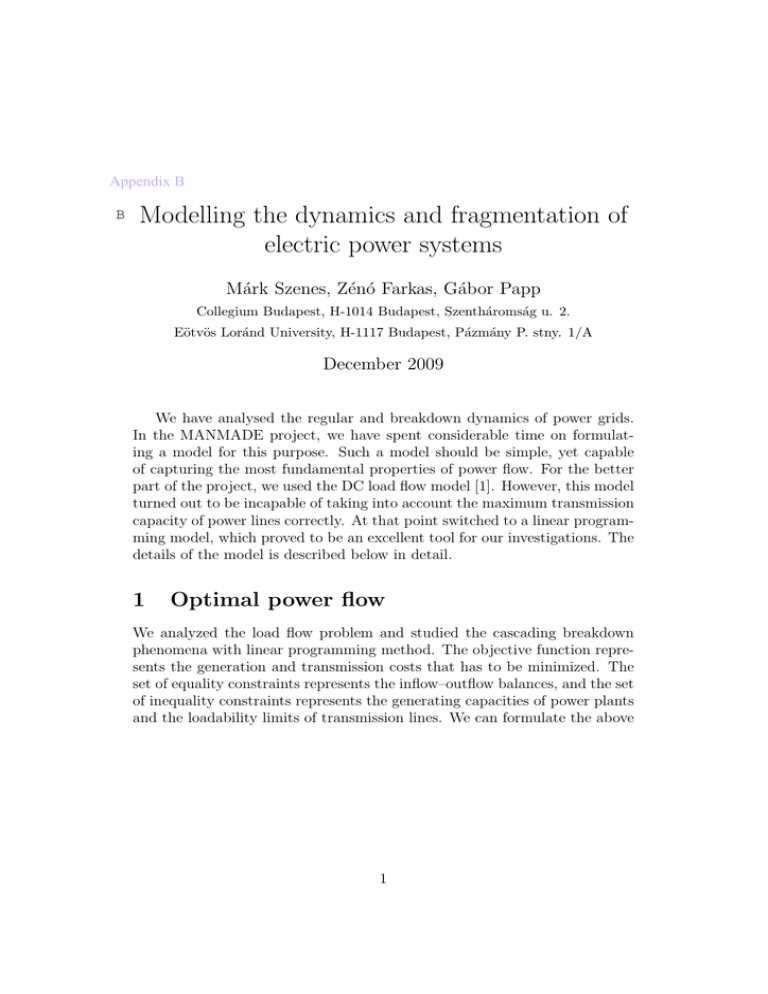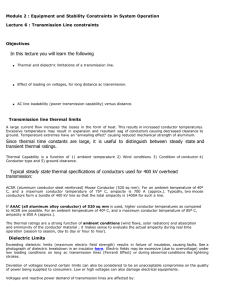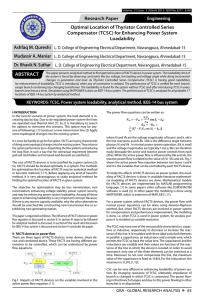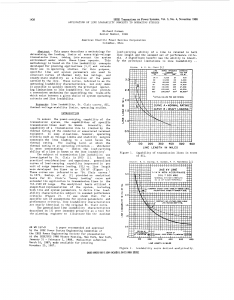Modelling the dynamics and fragmentation of electric power systems
advertisement

Appendix B
B
Modelling the dynamics and fragmentation of
electric power systems
Márk Szenes, Zénó Farkas, Gábor Papp
Collegium Budapest, H-1014 Budapest, Szentháromság u. 2.
Eötvös Loránd University, H-1117 Budapest, Pázmány P. stny. 1/A
December 2009
We have analysed the regular and breakdown dynamics of power grids.
In the MANMADE project, we have spent considerable time on formulating a model for this purpose. Such a model should be simple, yet capable
of capturing the most fundamental properties of power flow. For the better
part of the project, we used the DC load flow model [1]. However, this model
turned out to be incapable of taking into account the maximum transmission
capacity of power lines correctly. At that point switched to a linear programming model, which proved to be an excellent tool for our investigations. The
details of the model is described below in detail.
1
Optimal power flow
We analyzed the load flow problem and studied the cascading breakdown
phenomena with linear programming method. The objective function represents the generation and transmission costs that has to be minimized. The
set of equality constraints represents the inflow–outflow balances, and the set
of inequality constraints represents the generating capacities of power plants
and the loadability limits of transmission lines. We can formulate the above
1
mentioned linear programming problem:
X g
X
min: ({Pi | i ∈ V g } , {Fij }) 7−→
Ki · Pi · ∆t +
Kijt · Fij · ∆t (1)
hiji
i∈V g
Pi
Pi
|Fij |
=
X
≤
≤
j∈{hiji}
Cig
Cijt
Fij
(2)
(i ∈ V g )
(3)
(4)
1. Pi denotes the actual power produced/consumed by the power plant/consumer
i, measured in MW.
2. Fij is the power flows from i to j, measured in MW.
3. Kig is the generation cost of the power plant i (which is element of the
set of the power plants V g ), measured in EUR/MWh.
4. Kijt is the transmission cost. For the sake of simplicity we choose it to
depend only the transmission line length lij , so Kijt = K t · lij (the unit
of K t is EUR/MWh·km).
5. Cig is the nominal capacity of power plant i, measured in MW.
6. Cijt is the line loadability, measured in MW.
The advantage of the application of linear programming technique described above is that it takes into account economic considerations under
given physical constraints. Thus this method fairly reproduced the operation of the power transmission system operator that is responsible for the
most effective and reliable distribution of power.
2
Parameterizing the model
Our electricity network database [4] contains the information about:
• the network topology – the set of edges {hiji} and nodes {i} (with
country information)
• the length (lij ) and the voltage level (Uij ) of transmission lines
• the fuel type (nuclear, coal, natural gas, fuel oil, lignite, wind, biomass,
hydro, etc.) and the nominal capacity of power plants (Cig )
2
• the population belongs to the nearest substation
Hourly consumption data of European countries available from the page of
the European Network of Transmission System Operators [2]. Combined
with the population information we assigned the consumption values (Pi ) to
the consumer nodes in the ratio of the corresponding populations.
The determination of the generation and transmission costs (K g and K t )
is based only on expert estimation which doesn’t take into account political
and geographical and such specific factors that can affect the real costs. In
our model the generation cost depends only on the fuel type of the power
plant.
3
Line loadability
For the purpose of determining the line loadability, we apply the method
originally proposed by St. Clair [6], and which later on analytically derived
by Dunlop et al. [5]. Although the method has some limitations, and is
based on several assumptions (like the neglect of resistance, the terminal
system impedance and the effect of series or shunt compensation etc.), it is a
good approximation for quickly estimating the line loading limit. The papers
cited above showed that the loadability characteristics for uncompensated
high voltage transmission lines is universal, the maximal power in units of
surge impedance loading (SIL) is independent of voltage levels, and depends
only the line length. Three factors influence the maximal power that can be
transmitted, these are:
1. the thermal limitation;
2. the line-voltage-drop limitation;
3. the steady-state-stability limitation.
The thermal limitation is relevant only for lines shorter than 80 km, and
within this range the maximal power is approximately 3 · SIL. The maximum allowable voltage drop along the line is 5%, and relevant in the 80–
320 km region. The steady-state-stability limitation is important for lines
longer than 320 km. The steady-state-stability margin is defined as 100% ·
(Pmax − Plimit ) /Pmax and it is assumed to be 35% (corresponds to δ = 40.5◦
power angle). Fig. 1 shows the loadability curve, which we used to determine
the power transmission capability of the transmission lines in our load flow
simulation. This is the so called St. Clair curve which gives the load carrying
capability in the units of SIL. We applied the following typical SIL values
(Tab. 6.1 in [3]):
3
3.5
2.0
1.5
0.0
0.5
1.0
Pmax SIL
2.5
3.0
35% steady−state−stability margin
5% voltage−drop margin
St. Clair curve
0
200
400
600
800
1000
Transmission line length (km)
Figure 1: Loadability curve for uncompensated overhead transmission lines
Voltage levels
SIL
230 kV
345 kV
500 kV
765 kV
1100 kV
140 MW 420 MW 1000 MW 2280 MW 5260 MW
For other voltages we interpolated the SIL values correspond to the nearest
voltage levels.
4
Breakdown process
A failure in the power network can cause successive failures which can propagate to the whole system. For example, when a transmission line (power
4
plant) fails, the other lines (power plants) have to supply the missing carrying (generating) capacity that may lead to overload of some network components. This cascading failure mechanism causes the large blackouts, like
the disturbance of the European power system on 4 November 2006, when
the European interconnected power system was split into three independent
parts [7].
In our linear programming approach (with linear equality and inequality
constraints) there is no information about which line become overloaded,
because if a constraint can’t be satisfied the linear programming problem
became infeasible. To find the weak lines in the system and to perform the
cascading breakdown process we followed the next steps:
1. Decreasing the total consumption P to the limit Plim , where the solution
of the problem still doesn’t exist, but for appropriately small further
decrease of Plim the problem becomes feasible
2. Finding the lines which the problem should become feasible with at
Plim if they have infinitely large capacity
3. Removing the lines found in the previous step. Updating the total
consumption P if some node(s) dropped out.
4. Repeating these steps unless the electricity network becomes operable
again
References
[1] B. F. Wollenberg A. J. Wood. Power Generation, Operation and Control.
John Wiley & Sons, New York, 1996.
[2] ENTSO-E. www.entsoe.eu.
[3] P. Kundur. Power System Stability and Control. McGraw-Hill, New York,
NY, USA, 1994.
[4] Platts. www.platts.com.
[5] P. P. Marchenko R. D. Dunlop, R. Gutman. Analytical development
of loadability characteristics for ehv and uhv transmission lines. IEEE
Transactions on Power Apparatus and Systems, PAS-98:606–617, 1979.
[6] H. P. St.Clair. Practical concepts in capability and performance of transmission lines. Power Apparatus and Systems, Part III. Transactions of
the American Institute of Electrical Engineers, 72:1152–1157, 1953.
5
[7] UCTE.
Final report - system disturbance on 4 november
2006.
http://www.entsoe.eu/fileadmin/user_upload/_library/
publications/ce/otherreports/Final-Report-20070130.pdf, 2007.
6




